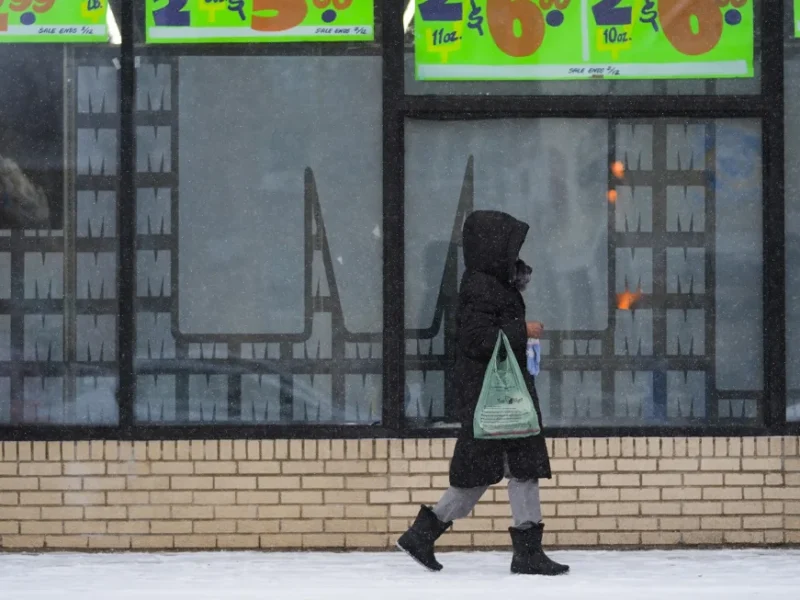America’s economic engine is struggling at the moment.
Consumer confidence is plummeting, debt levels are rising, job concerns are increasing, and people are becoming more cautious, reducing their spending.
Despite this, the fundamental factors supporting consumer activity are still in place, though risks have intensified.
High inflation and interest rates have made consumers more vulnerable, especially when faced with the unpredictability of the Trump administration’s policies—such as large tariffs expected to drive up prices—leading to decreased spending and investment plans.
“The consumer sees darkening clouds for the economy ahead,” said Chris Rupkey, chief economist at FwdBonds, after two key economic reports highlighted the struggles of American consumers.
The Commerce Department reported a minimal 0.1% increase in inflation-adjusted consumer spending in February, as Americans focused on saving, while a separate survey revealed a 12% drop in consumer sentiment in March. “And while they may not always be right, if they do not start spending again, this latest negative reading on confidence will become a reality,” Rupkey added.
Consumer spending drives over two-thirds of the nation’s economic activity; if it falters, the economic consequences could escalate.
“Consumers need both willingness and ability,” said Dan North, senior economist at Allianz Trade North America. “They lack the willingness (consumer confidence), and their ability (income) is shrinking.”
“It’s not nonexistent, but it’s very weak.”
Although Friday’s Commerce Department data showed solid gains in personal income for the second month in a row, real (inflation-adjusted) income after taxes increased by just 1.8% year-over-year.
“That’s pretty weak,” North commented. “It’s not zero, but it’s pretty weak.”
He noted that if both disposable income and confidence continue to decline, a drop in core spending is likely to follow.
However, it’s still uncertain whether the sluggish spending in January and February was driven by recession or inflation concerns, or if it was simply a pullback after a spending surge in the final months of last year, said Shannon Grein, an economist at Wells Fargo.
“While real spending was weak and there were some downward revisions to the previous month’s data, I think it’s still a bit too early to dismiss the consumer,” Grein added.

The slow consumer spending in January and February could either be a sign of economic concerns or simply shoppers taking a break after the holiday season.
Wages are still growing faster than inflation, and overall income growth remains strong due to a tight labor market.
However, the stability of the job market is crucial.
“That’s the big risk: Will labor market data start to shift in a way that causes consumers to cut back on spending?” she said. “But the key factor for households is income, and that remains in a relatively strong position.”
“Preparing for a slowdown.”
However, Grein warns that this isn’t true for all households.
A key trend in the post-pandemic recovery has been the growing divide in American household finances. Lower-income and younger consumers are facing more difficulties, living paycheck to paycheck, and are likely to bear the brunt of tariff pressures, she noted.
Debt levels and delinquencies have been rising.
“We’re seeing lower-income and younger borrowers driving up delinquency rates—they’ve reached their limits,” she said.
On a broader scale, however, the health of consumers’ mortgage loans, which represent the largest portion of household debt, is helping to counterbalance these concerns.
“Mortgage delinquencies are only nearing pre-Covid levels, where they were historically low,” she said. “Equity in the single-family housing market is still near record highs.”
Still, she cautioned that prolonged uncertainty could lead to unpredictable behavior from both consumers and businesses.
“I think the uncertainty is leading to more behavioral changes than just the direct impact of tariffs,” she said. “The recent data raises the question: ‘Is this just a temporary effect of tariffs, where people are reacting to the uncertainty, or is this a sign of underlying weakness finally showing in the data?’”
While Grein and Wells Fargo don’t predict a recession, a general slowdown seems likely.
“I’m preparing for a slowdown in growth, based on the current wait-and-see approach by businesses, households, and the Federal Reserve,” she said. “I don’t think we’re too far gone, but the longer the uncertainty lasts, the more concerned I get about growth.”
“If people are unemployed, they won’t be able to spend.”
Victor Yarbrough is aware of the growing economic divide. He is one of three brothers behind Brough Brothers Distillery, the first Black-owned bourbon distillery in Kentucky.
The distillery is located in Louisville’s West End, where the brothers grew up. Once known as the “Harlem of the South,” this area has faced significant economic challenges, particularly in recent decades.
Yarbrough noted in an interview with CNN that conditions seem to be worsening for some local residents.
“Two blocks away, there’s a church that holds food drives, and we’ve noticed more people leaving with food baskets each time,” he said. “That’s a sign that for many, even in an already struggling area, things are getting tougher.”
Meanwhile, Brough Brothers is undergoing a major expansion, including a second, larger facility with an event space, and had plans to expand internationally. However, retaliatory tariffs on American whiskey and bourbon from the European Union and Canada have disrupted those plans.
Yarbrough said his company is doing everything it can to adjust but is concerned about how his customers will manage if prices on goods rise.
“We’re very competitively priced, but the reality is, if people don’t have jobs, they can’t spend,” he said. “We’re not a necessity. We’re not like eggs and milk.”











